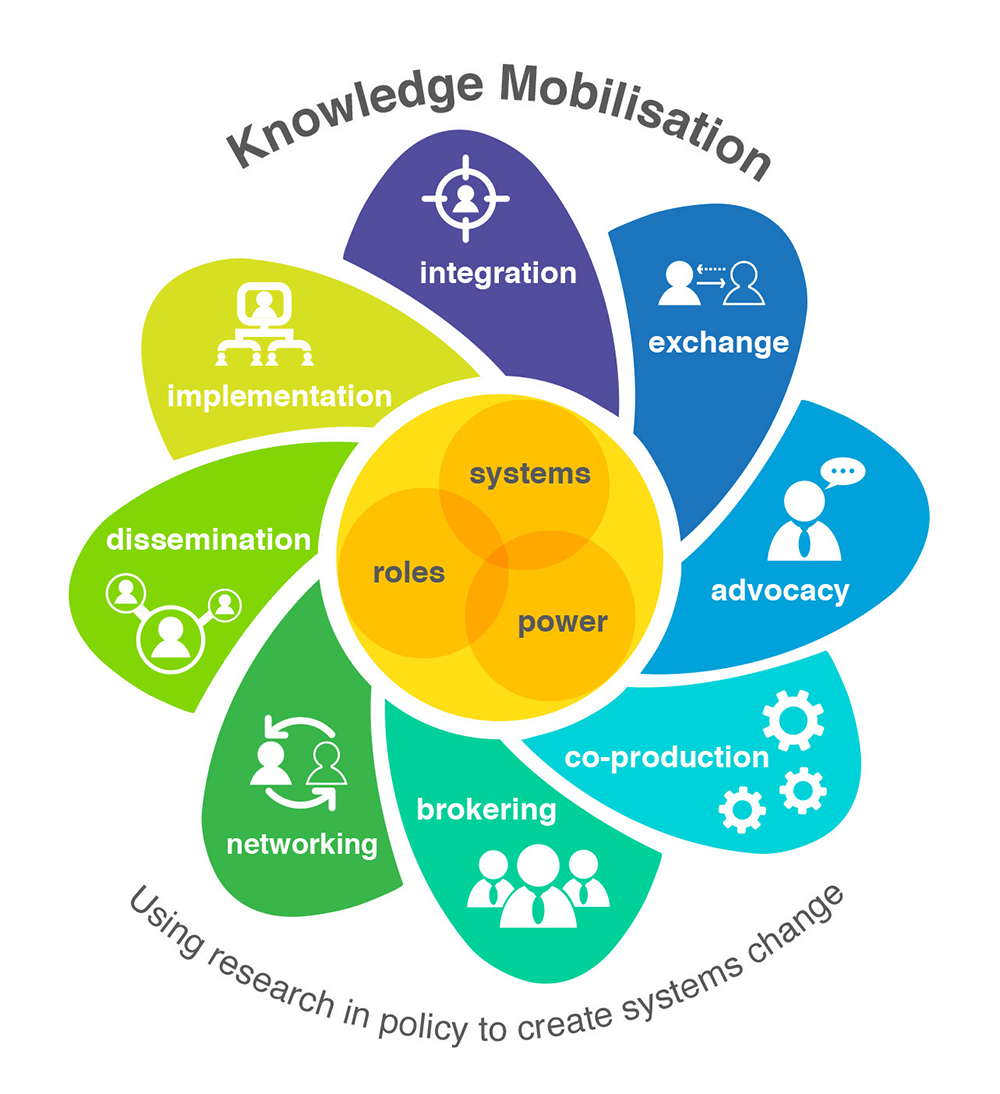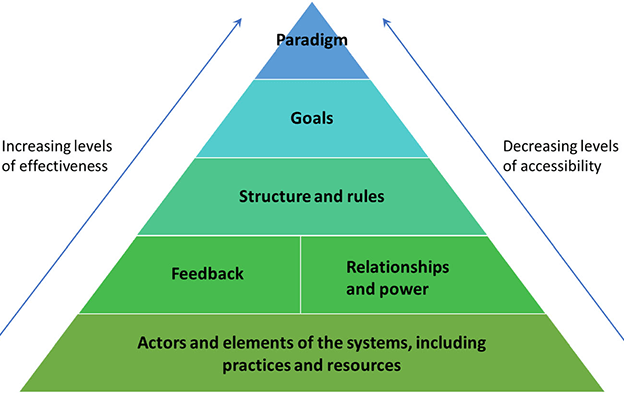Knowledge mobilisation framework
Page contents
What is knowledge mobilisation?
Knowledge mobilisation describes how knowledge is created and used to inform policy and practice. It is defined in literally hundreds of ways in the literature. At the Prevention Centre, we define it as the overarching process of moving knowledge to create and enhance research impact into policy and practice.
Knowledge mobilisation is a relatively new term that comes from the implementation science literature. There are many different definitions; however, most of these centre around making academic research accessible through a deliberative approach to creating purposeful connections between the researcher and the research user, with the goal of improving the quality of the research itself and making it more likely to be used in public policy and professional practice.
‘Mobilising’ implies a social interaction and involves an iterative process of co-creation of knowledge through a collaborative process i.e. knowledge mobilisation offers an approach to improving the usefulness of research through making research outcomes more accessible to non-academic audiences. We also recognise that context is important, and that research itself is improved when informed by the knowledge and experience drawn from applied policy and practice settings.
Many knowledge mobilisation strategies are similar to communications strategies. Communications involves developing the strategy, channels and tools to transfer knowledge. Communications is an integral tool of knowledge mobilisation.
Knowledge mobilisation strategies
Knowledge mobilisation can incorporate many different strategies. These can include: implementation, dissemination, networking, brokering, co-production, advocacy, exchange and integration,
Knowledge mobilisation strategies are best applied right from the start of the research – such as refining the research question to ensure relevance for end-users, and using co-production. However, knowledge mobilisation can be used at any stage throughout the research process.
Each strategy should be carefully chosen to suit the situation at hand. An analysis of the system with which the knowledge is attempting to interact can be beneficial in determining the best strategy. Taking a systems thinking approach can help to determine who may hold the roles and power in the system and how to leverage these for the knowledge mobilisation process.

A systems approach to knowledge mobilisation
In the literature, linear models describing knowledge transfer and translation have moved towards multi-directional approaches that take into account the complexity of the systems we are trying to influence.
A systems approach to knowledge mobilisation is where knowledge is produced and becomes meaningful through social processes.
Haynes et al have found that using systems thinking can enhance and fundamentally transform knowledge mobilisation. Previous literature suggests six key areas or leverage points to target when applying a systems approach to organisational change.
Leverage points for changing complex systems
This pyramid diagram includes six suggested areas to target. The area at the bottom has the least effectiveness but the most accessibility, and vice versa at the top level.
These leverage points in a system are conceptualised as a hierarchical framework in which change is harder to achieve at the upper levels but, if successful, is likely to be more transformational. Leverage points in the lower levels are needed to target upper-level levers.
Understanding the system within which your research sits and how and where you are trying to influence is a key step to developing targeted knowledge mobilisation strategies.

Developing a knowledge mobilisation systems mindset
The Prevention Centre has synthesised a series of targeted questions from the literature. These 13 questions are designed to create a ‘guide’ for systems thinking in knowledge mobilisation and develop thought processes conducive to further developing knowledge mobilisation plans.
We suggest you reflect on these questions before you start your research, or shortly after it has started. You can keep coming back to them during the research process as a reflective process during this time.
This guide is based on the hierarchy of leverage points above and give practical points to reflect on. These ‘questions’ do not necessarily need written answers, but it can be something you use to reflect on with your research team and decide which leverage points are most applicable to your research and where you may focus your energy and efforts.
Developing a knowledge mobilisation plan
At the Prevention Centre, we have adapted eight key archetypes of practice in knowledge mobilisation identified by Davies et al. These were developed from a large body of empirical work on mapping knowledge mobilisation within healthcare.
Use these archetypes to reflect on your work, as a method to develop knowledge mobilisation planning. Firstly, what is happening now under each archetype for your project? And secondly, what are the future plans?
Your projects may not have something to document for all the archetypes. There is no right or wrong – the archetypes describe the breadth of knowledge mobilisation activities, not best methods for your context.
Reflect on these against the systems thinking guide that you have just completed. How can you effectively use these strategies to mobilise the research knowledge you are creating?
Knowledge archetypes
Knowledge mobilisation checklist
The knowledge mobilisation checklist can then be used as a checklist to focus the knowledge mobilisation strategies within this system, if needed.
A useful undertaking at this time is stakeholder mapping. See how you are involving stakeholders in the research process and how you can target them with communications strategies (See User Guide chapter on how to write a communications plan).
Further reading
-
Knowledge mobilisation at the Prevention Centre
What is knowledge mobilisation and why do we need it? This PDF factsheet defines knowledge mobilisation and explains why it is a useful tool. -
Knowledge mobilisation and partnership research: Reflections from the Prevention Centre
In this video, Dr Michelle Irving presents how the Prevention Centre is mobilising chronic disease prevention research to increase uptake in policy. -
Developing a systems thinking guide for enhancing knowledge mobilisation in prevention research
-
Applying systems thinking to knowledge mobilisation in public health
-
Knowledge mobilisation in practice: an evaluation of The Australian Prevention Partnership Centre
-
Mobilising knowledge to improve UK health care: learning from other countries and other sectors – a multimethod mapping study
Thank you to Dr Michelle Irving for development of this framework.
Key archetypes of practice in knowledge mobilisation adapted from Davies HT, Powell AE, Nutley SM. Mobilising knowledge to improve UK health care: learning from other countries and other sectors – a multimethod mapping study. Health Services and Delivery Research. 2015;3(27).
More from the CERI User Guide
This chapter of the User Guide is one in a series available from The Australian Prevention Partnership Centre website. It was prepared by members of the Collaboration for Enhanced Research Impact (CERI) Coordinating Group to provide practical tips on knowledge mobilisation and science communication for researchers working in the prevention of chronic disease.

About CERI
The Collaboration for Enhanced Research Impact (CERI) is a joint initiative between the Prevention Centre and several NHMRC Centres of Research Excellence, established in June 2020 to enhance the profile and impact of chronic disease prevention in Australia. We are working together to find alignment in the policy and practice implications of our work and to develop shared communications across our various projects and participating centres.


